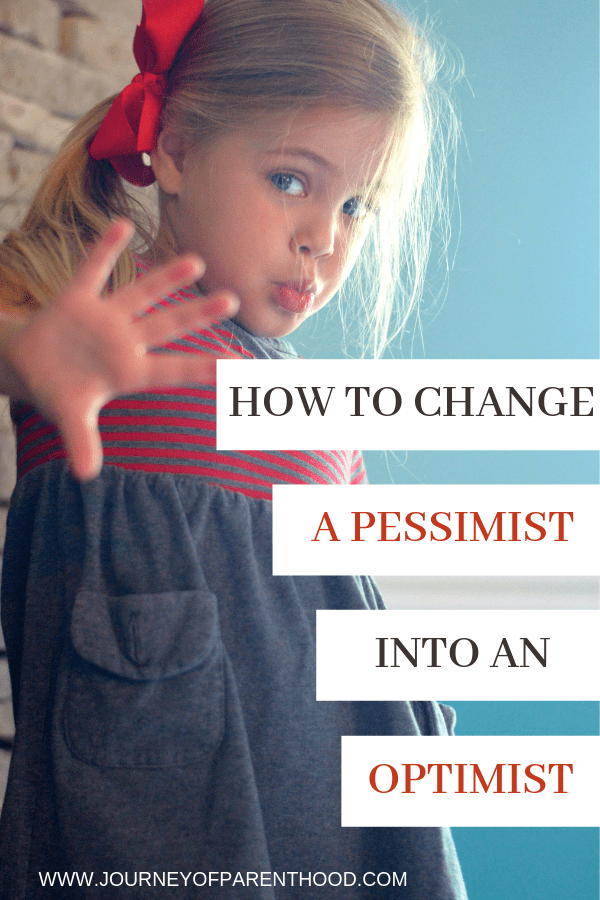How to Turn a Pessimist into an Optimist
Today is Babywise Friendly Blog Network Day.
I think one of my favorite things about having this blog trading day is that we get a chance to feature fellow bloggers but we also get to give input on some topics we’d like to read about.
I have a child who sees the world as “glass half empty” and I’ve been really needing help in how to parent that attitude and how to help guide that outlook into one that is more optimistic.
I’m so thankful to Valerie (from Chronicles of a Babywise Mom) for writing on this topic for me personally and I know it’ll be a huge help to fellow mamas too!

As a parent, a pessimistic child can almost be infuriating.
You can plainly see how good your child has it, and yet the complaints and moping ensue.
Beyond the frustration lies concern.
A pessimistic child is looking at that glass as half empty, and you more than anything want your child to be able to enjoy life and see it as half full.
Perspective is huge, and the child who can see the positive spin rather than that negative is going to be a happier person in life.
“Research shows that optimists, who believe they can achieve success, are in fact more able to do so. They are less likely to get depressed, get fewer illnesses, have longer relationships, and live longer.” Aha! Parenting
So much about children is just nature. It is who they are when they get here. Yes, you can and do have a strong impact on your child as the parent.
If you are a pessimist, you will feed pessimistic viewpoints in your children. The inverse is true if you are an optimist.
Among my four children, I have one who is an extreme pessimist by nature and one who is an extreme optimist by nature.
The interesting thing is that both types bring along challenges.
If you have a pessimistic child, don’t look at the grass on the other side and assume the parents of optimists just have it easy.
With that said, having an attitude of optimism is a much happier way to spend life, so my husband and I have put a lot of effort into helping our pessimistic child have optimism in life.
It has worked. It has taken years. Literally. But strides have been made. We have seen fruits from our labors.
In preparation for writing this, I sat with my pessimistic child and asked what has changed; what were the key things to help bring optimism instead of pessimism?
What is Pessimism?
First, let’s discuss some signs to watch for to help you know if your child is pessimistic.
- Your child thinks the worst will happen.
- Your child completely over-exaggerates a reaction when something doesn’t go as planned or goes less than perfectly.
- Your child uses words like “always” and “never” when things don’t go his/her way.
- Your child won’t try at anything in life unless he/she is sure he/she will be totally amazing at it.
- Your child has a hard time when he/she makes a mistake.
- Your child takes something that is very good and finds the one possible negative thing and fixates on it.
A lot of this list can also be attributed to an oldest, perfectionist child.
You might see pessimism often in the oldest boy and/or oldest girl in the family (so even if your daughter is the second child, if she is the first daughter, she is the oldest girl in the family).
On to what to do about optimism.

Be Optimistic Yourself
I said earlier that children come with a lot of tenancies by nature.
This is fully true. Your child can naturally lean to pessimism or optimism.
But your child learns a whole lot from you.
When it comes to raising children, more is caught than taught.
If you spend the days point out the “half-full” side of the situation, your child will start to do the same.
Keep your dialogue optimistic and your child will notice.
Talk About Perspective
Is the glass half-full or half-empty?
It is all about how you look at it. It is.
It is the same glass. Some see it half way full. Some see it half way empty.
The glass is the same. The water level is the same. All that is different is the perspective.
When I talked to my child about what helped to finally be more optimistic in life, the response was, “Well, I just finally realized that situations weren’t going to change. They are what they are. The only thing that can change is my attitude about it.”
Use language like, “You choose how to feel” in your home.
Do not allow your child to say things like, “He made me mad!”
Correct your child, “No, you chose to be mad when he acted a certain way.”
Make sure the language in your home is such that your children realize that their feelings are choices sand they have control.
This is why it takes years, really. We are training the brain to see the world differently. We are teaching it to look at things and take a positive spin rather than a negative one.

Be Patient and Offer Help
Again, we are training the brain to think differently.
Your child’s natural impulse is to be an Eeyore. That is the knee-jerk reaction.
One little pep talk from you won’t change that. A pep talk can help and is a good step.
Your good example is a huge hurdle overcome.
You can help your child by pointing out the bright side when things go wrong.
Things go wrong every day! That is life. Life is full of curve balls.
When your child declares how the world is over because XYZ happened, point out how things will be okay. That life isn’t done.
Point out the half-full view-point.
Explain that your child doesn’t know if something is for sure going to fail or not.
Teach your child to learn to think that way by patiently and consistently feeding those positive thoughts to your child.

Have Your Child Do Something That Takes Time and Practice
All of my children take piano lessons starting in Kindergarten.
My children can look back and see how far they have come.
A great thing about an instrument is that most people aren’t good at it until they have practiced, and practiced a lot.
At your child’s first soccer game, there will be kids who are stand-out amazing.
If your child is a pessimist, he might stop trying at soccer right then and there because he isn’t that good.
With piano, the vast majority of people have to learn little by little, so children feel okay about needing to work at it.
It is so helpful for them to have
We have also required our pessimistic child to stick to things that weren’t the forte and natural gifts in life.
For this child, it was sports.
All other things in life are so each for this child, where sports have taken work, practice, and effort.
This child didn’t want to try from a young age. Not the best? No thanks. But we insisted, and big improvements have been made.
To make this idea work, you have to point out how practicing and experience help build skills.
As your child sees improvements and grows, be sure to point out and celebrate those victories!
Help your child recognize that hard work paid off.
Point out that your child had to practice to get there. Help your child recognize work is required.
Have Parent/Child Interviews
Parent/child interviews are super helpful for all of your children. Meet once a month.
Discuss challenges and victories in life.
This is a way for you to check in with your child and see how the efforts are going to be more optimistic in life.
For more information on this idea, see my post on Private Interviews With Children.
Conclusion
Teaching your child to be optimistic is a long road. There isn’t a quick fix.
You can get there, though!
Work together to help your child view the bright side. You can both find success!
Valerie blogs at www.babywisemom.com.






